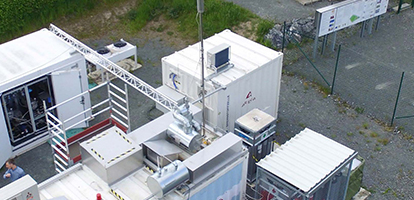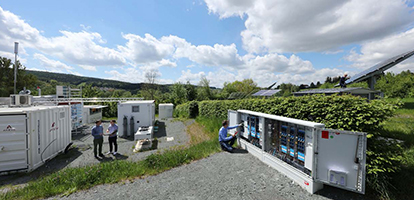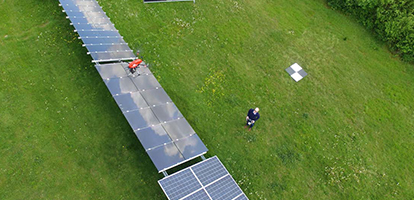



The Bavarian Centre for Applied Energy Research is testing how storage devices can help to equip local networks for the increased supply of solar electricity. Controllers from WAGO ensure secure communication between individual systems and the control center.
The integration of current from fluctuating sources into the low-voltage networks is one of the greatest challenges of the energy transition. The Bavarian Centre for Applied Energy Research (ZAE Bayern), together with partners from science and industry, has initiated a field test in the small city of Arzberg in Oberfranken that should provide some solutions. “How is it possible to link a large number of PV arrays into the local network without having to expand the latter at high costs? How can the local networks be operated securely and efficiently in the future, when more renewable energy systems are supplying the current?” are two of the questions behind the project, according to Project Leader Philipp Luchscheider from ZAE Bayern.
To gain answers, the researchers established a smart grid test center in the Schlottenhof district of Arzberg. In addition to PV modules with a total peak output of approximately 50 kilowatts, the facility includes three redox-flow batteries as short-term buffers, and an electrolysis system with a hydrogen tank and fuel cell, for long-term storage. A drop cable connects the test field to the local network in Schlottenhof. The location offers the best conditions for the project, because many households operate solar arrays, and some are equipped with residential storage units. The test will conclude at the end of this year.
Controlling Storage Devices Intelligently
“To balance the fluctuating production and to smooth out supply peaks, short- and long-term storage devices must cooperating in an intelligent way. This includes taking weather predictions and expected consumption into account,” explains Luchscheider. This tasks are performed at the control level using a powerful server; the control center itself is located in a prefabricated office at the edge of the test center. The computer generates instructions with the aid of simulations and mathematical models, which it then transmits to the storage devices as signals.
Controlling such a complex system requires reliable information about the state of the storage devices and the PV array, and about the network load and capacity. ZAE Bayern collects detailed data from all of the system components every second of every minute. Production and consumption from twenty Schlottenhof households, four with battery stores, are also recorded every second, in addition to voltage, current, and phase angle at the local transformer station. The scientists also measure weather data, like local solar radiation or wind speeds The data are transmitted to the central server via a VPN tunnel, linked to predictions about solar production and network load, and processed into control signals.
How does this type of control actually function? For example, on a sunny day, the battery storage units in the households do not start charging early in the morning, but instead somewhat later, so that they still have free capacity when the solar arrays reach maximum production. Those who own the storage devices don’t see any change – the batteries are still charged when they need electricity in the evening. The server calculates the optimum point for energy intake based on the network and system data with the weather and load predictions.
Open and flexible
“The quality and availability of the data exert enormous importance on the success of our field test,” emphasizes Luchscheider. This was the reason why ZAE organized the communication between the individual components and the control center using a WAGO PFC200 Controller. “The WAGO product is extremely reliable. We have never had a problem,” declares Luchscheider. In addition, the controller guarantees the researchers have a maximum level of flexibility in configuring their field tests. “Due to the many different inputs, the solution from WAGO allowed us to connect the individual systems and aggregates without limitations,” explains the project leader. 3-phase power measurement modules from WAGO were used to measure voltage, current, and phase angle. The data exchange is carried out over the Internet using GSM and DSL. “Not every manufacturer offers all of this,” states Luchscheider.
The researchers also profited from the PFC200’s flexibility when it came to programming. The WAGO controllers are able to process data using our preferred programming language R. This is important to us, because we can use the same code to develop our models and for the controllers. This saves time and prevents errors during porting.” Data transfers between controllers and servers use the MQTT protocol, “which is very efficient and offers additional advantages during configuration,” explains Luchscheider.
The openness guaranteed by the WAGO components and the control platform provides the scientists with the opportunity do develop additional scenarios and to test new algorithms. “For this, we are going to need new hardware, that we can test in industrial situations or projects, and integrate into the system,” declares Luchscheider. The test center that ZAE operates in the future will also have space for additional new technologies that need to be prepared for the smart grid.
Strength and Reliability
Some of the controllers are mounted directly in the solar arrays, so that the scientists can test the supply behavior of different modules and devices during different weather conditions. With only scant protection from the modules, these controllers are exposed to wind, rain, snow, frost, and heat. The technology experienced no problems. “We have not lost a single measured value since the project began. The controllers are definitely suitable for outside use,” exclaims Luchscheider.
As is the case in many other rural towns, communities, and villages, Schlottenhof also produces a large portion of the power it consumes – thus, the ability to provide PV current in a targeted way, has enormous potential for the future. ZAE Bayern and its partners in the research project are contributing to a vision of a climate-friendly, decentralized energy supply in Schlottenhof and elsewhere, without necessitating an expensive expansion of the local network.
Text: HEIKO TAUTOR | WAGO
Photo: KURT FUCHS | ZAE BAYERN